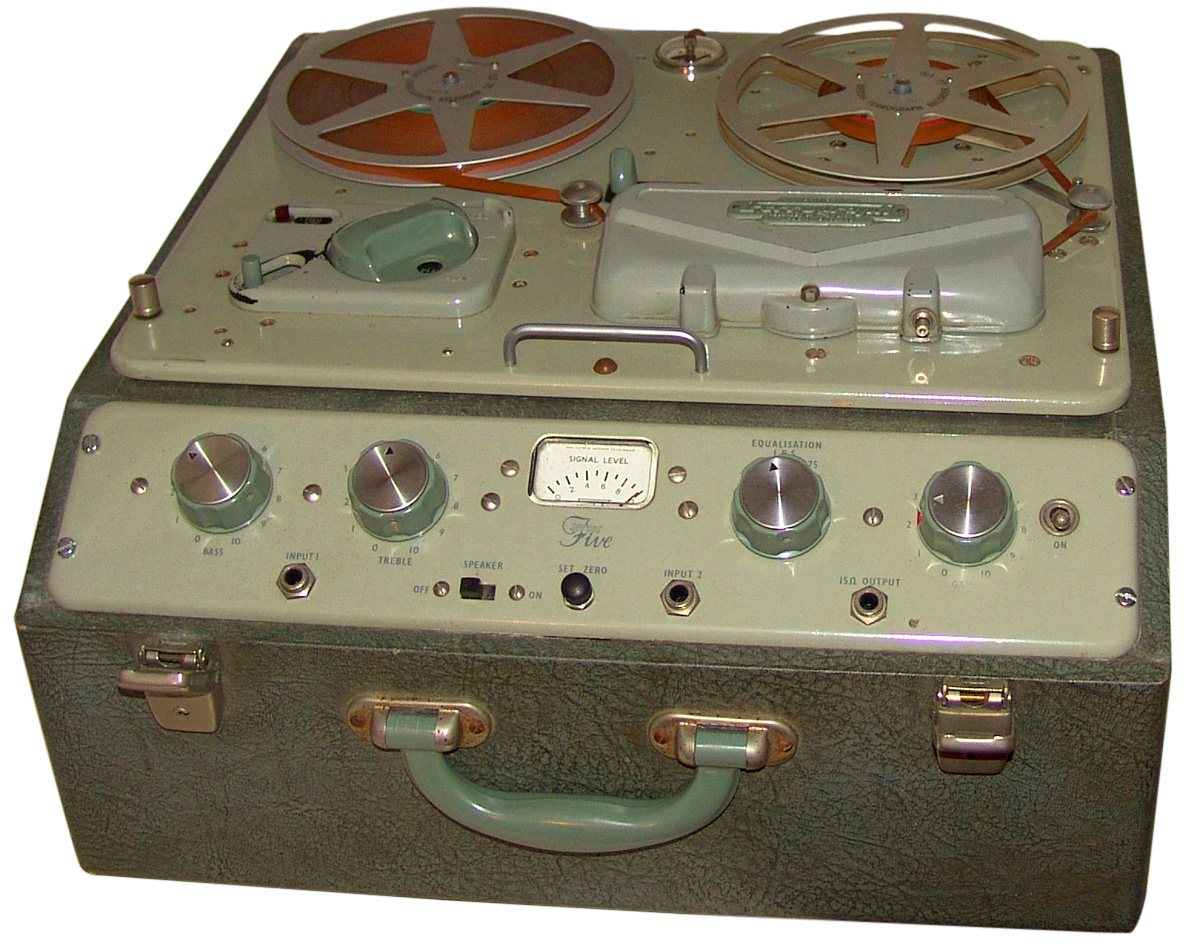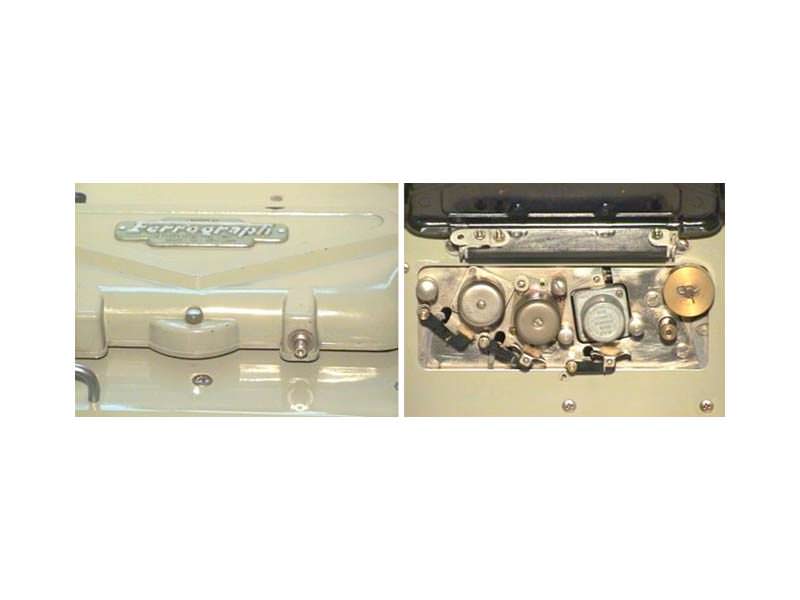Technical Details
Brand: Ferrograph
Model:Series 5
Category:Super High Fidelity
Application:Consumer
Electronics:Solid State
Equalization:IEC
Country of Manufacture:United Kingdom
Release dates:1963 - 1966
Tracks:1/2 Rec/PB
Speeds: 3 3/4, 7 1/2
Max Reel Size("): 10.5"
Number of heads: 3
Dimension: 18½ x 17½ x 9½" ( 470 x 444.5 x 242 mm)
Head Composition: Permalloy
Head Configuration: Stereo
Auto Reverse?:No
Voltage(s): 220-240v
Frequency Response:7½ ips: 40Hz -15kHz (3 dB)
Wow and Flutter:less than 0.16 per cent at 7½ ips
Signal-to-Noise Ratio:better than 50 dB in the range 200Hz to 15kHz
Sound quality rating:7 / 10
Long-term reliability rating: 6/ 10
Weight: 49¾ lbs (22.3 kg)
Additional Details
Description
For the Series 5, Ferrograph enhanced the specifications of their tried and tested (and by now almost 15 year old) design. Cosmetically, not much had changed from the Series 2, 3 & 4 except
for the knobs and VU meter, but a new capstan/flywheel assembly gave improved wow & flutter figures of less than 0.16% at 7½ ips (0.2% for the series 4). This was achieved by by reducing the capstan diameter so that a heavier flywheel now ran at twice the speed.
The frequency responses at both 7½ & 3¾ ips were also extended, giving 40 – 15kHz & 40 -10kHz respectively.
Additional Info
By John Borwick (Copyright Print & Press Services Ltd.1965)
The Ferrograph Series 5 was introduced at the end of 1962 and, while making a few superficial concessions to modernity, sufficient to earn a Design Centre approval tag, it has retained the tried and trusted functional features of its predecessors. Indeed, by reducing the capstan diameter so that a heavier flywheel now runs at twice the speed, wow has virtually been eliminated.
Operation of the Ferrograph is not materially different from that of other recorders though, unlike most, the selection of the operational mode-play, record, re wind or wind on-is divorced from the start and stop controls. The function selector switch is near the left-hand spool. It is a four-position rotary switch and the selected function appears through a round window in the knob itself. Having turned this switch to the required position, you start the motor(s) by, pulling a “start” lever to the side.
To stop, you press a small red button.Once the start lever is pulled to the side, the starting bar which it operates is held in the “on” position by an electromagnet (or solenoid) until either the stop button is pressed or the automatic stop is tripped. The latter is a tension arm resting against the tape, between the capstan and the take-up spool, during play or record. When the tape runs off the end, or breaks, or the sake up spool is accidentally touched, the arm moves inwards and causes the “hold on” solenoid to be short-circuited.
The start lever also serves as a pause control during play or record. Sliding it back towards the off position moves the pressure roller out of engagement with the capstan, so bringing the tape to rest. A slight movement to the right locks the lever in position ready to give speedy, click-free starting when required.
The method of threading the tape is quite conventional, once the selector switch is set to one of the fast wind positions so that the pressure pads are moved back from the heads. The head cover is hinged and must be lifted to insert the tape. The free access this gives to the heads is also useful during tape editing and head demagnetising and other routine maintenance
operations.
Following the erase bead and record/re play head is a third head position. This carries a valve holder into which any Ferrograph record/replay head may be inserted. The Ferrograph 5A/N has a dummy head in this position but this may be replaced by a stereo head, to convert to model 5S, or a standard head for monitoring purposes.
A most useful feature which I would like to see on other makes of recorder allows you to adjust the height of the tape as it enters or leaves the spools. In this way you can eliminate the nasty scraping of tape against spool edge which is all too often a permanent accompaniment to the reproduction. On the Ferrograph you take the tape round a couple of “bobbin” guides. The effective height of these guides can be raised or lowered in a few seconds, to allow for even badly buckled spools.
The only other operational features on the tape deck are the speed change switch and the clock type tape position indicator. The latter is driven from the take-up spool, one revolution of the spool corresponding to one small division on the dial so that cueing indication is to an accuracy of one turn.
All other controls and jack sockets are on the sloping front panel. Reading from right to left, there is the mains on/off switch, volume control, equalisation switch (which must be at the same setting as the speed selector switch, 7½ or 3¾ on the 5A/N; 15 or 7½ on the 5A/H, or the start knob will not operate), record level meter (which has a right hand zero so that the spring assists the rapid indication of peaks, but slows the needle when it falls back), treble and bass controls. Beneath this row of controls are the jack sockets for high and low level inputs and external loud speaker output.
The high level input is rated at 150 mV, 80 Kohms and suits all the usual recording outlets on radio tuners, record players, etc. It will also record satisfactorily from 600 ohm lines and external loudspeaker outlets, though the usual precaution of fitting an appropriate resistor in parallel- 15, 7 or 3 ohms-to give correct matching is recommended. The low level input is rated at 3 mV, 1 Megohm. This suits any crystal or high impedance moving coil or ribbon microphone. Where low impedance types are to be used, and of course these are best because they allow you to employ long leads, the Ferrograph 30 ohms to 1 Megohm matching transformer must be inserted at the tape recorder end of the micro phone cable.
At the rear of the machine are the usual three-pin mains socket, a not-so-usual auxiliary octal socket providing HT and LT feeds for a tuner, etc., and two removable links. The first of these links is in auxiliary octal socket providing HT and it literally cuts off the erase and bias supplies to the deck when removed. A possible use of this link would therefore be, as a safety precaution, to remove it before putting the recorder in the hands of inexperienced operators who are to perform playback only of valuable tapes. A more sophisticated use is to insert a new plug, instead of the shorting link, wired to a separate rheostat or volume control. This allows you to ” fade erase ” previously recorded material and interject new recordings smoothly. The second link disconnects the erase supply only, and enables you to “superimpose” new material without erasing the old.
Two of Ferrograph’s own patent Hublok metal spools were supplied. These spools are an accessory that you either love, or hate. They incorporate two small spring loaded levers. The first springs back to grip .the spool spindle and so keeps the spool from rattling or falling off when the machine’ is being carried. The second raises a green catch on the hub into which you poke the loose end of the tape. Both these features can speed up and improve operations, once you have taken the trouble to get the feel of them, but I have met people who think they are a nuisance.
COMMENTS ON PERFORMANCE
Listening to tape records and some of my own tapes on the 10 x 6 inch built-in loudspeaker, I found the quality to be excellent by portable standards: that is remembering the inevitable limitations of any portable cabinet for good bass reproduction.
I was thus encouraged to replay the output through a hi-fl loudspeaker and found the frequency range and absence of background noise or distortion to be of a very high order. The Ferrograph output power is 2½ watts. Where more power is needed, for large rooms, a high fidelity amplifier could be included, but where quality only is concerned the Ferrograph amplifier may be rated as true hi-fl.
Plotting the frequency response confirmed these subjective findings, the record/replay graph being within ± 3 dB from 40 to 15kHz at 7½ ips and 40 to 10kHz at 3¾ ips as Fig. 1 shows. The range of the bass and treble controls is also indicated on the 7½ ips graph The playback only response, on CCIR test tapes, showed a falling off at high frequencies (see Fig. 2) which however is slight and will have the effect of making the machine more nearly compatible for replaying American NARTB characteristic tapes.
This is clearly a machine that deserves to be used in association with high fidelity equipment-a good external amplifier and/or loudspeaker, and a better-than-average microphone. The Reslo RBL/T ribbon microphone is recommended in the Ferrograph Manual (easily the best handbook I have yet seen supplied with a tape recorder) and one of these microphones was supplied with the machine for test. Good quality recordings were made with this microphone and also with a variety of domestic and professional microphones which happened to be to hand. I can confidently recommend this recorder, as I have been verbally recommending its predecessors for many years.
Rewind speed: less than one minute for 1,750 ft / Audio output power: 24 watts / Inputs: low (3 mV 1 Megohm). high (150 mV 80 Kohms)




